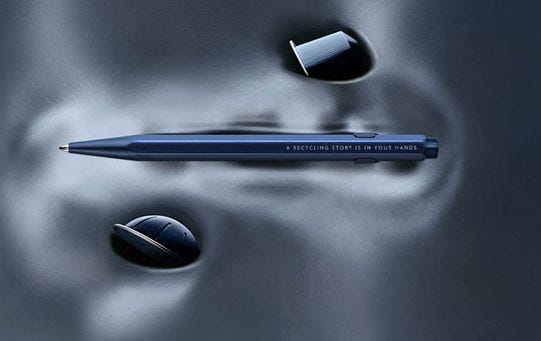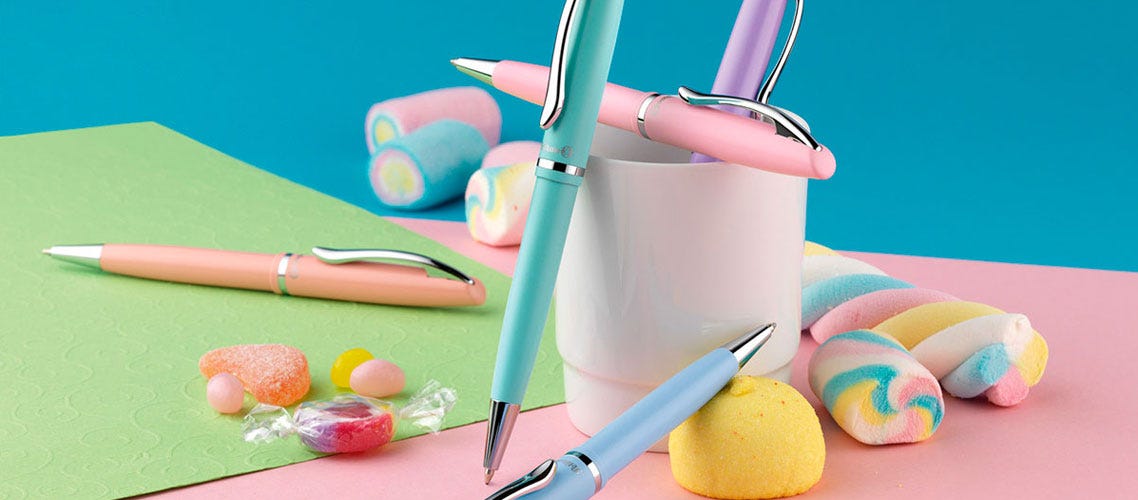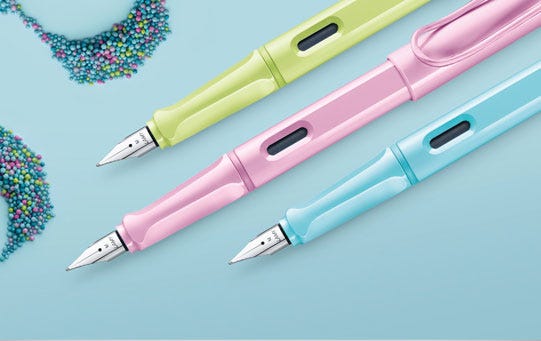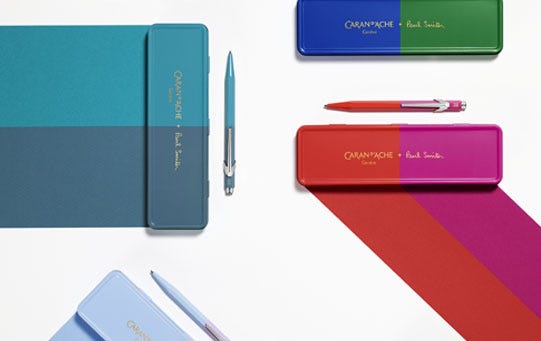A product has been added to the basket
Fountain Pen Filling Mechanisms Explained

Fountain Pen Filling Mechanisms Explained
Modern fountain pens come in many shapes and sizes and have a variety of ways to fill them with ink. We know for those new to the world of pens it can seem daunting to know which is which and how to choose.
There are really 4 main types of filling mechanisms in fountain pens today:
There are others, but these are mostly on vintage pens or ones replicating vintage designs, and you’d be unlikely to choose one as your first foray into fountain pens.
In this blog we will explain each filling mechanism and cover the pros and cons helping you make an educated decision on your next fountain pen purchase.
CARTRIDGE

Made of plastic, an ink cartridge is a small sealed ink reservoir, which can be replaced and the outer shell thrown away. Many pen brands use the “standard international” style cartridges (think Waterman, Faber-Castell and Kaweco), whilst others have their own proprietary ink cartridges (including LAMY, Parker & Cross).
| PROS | CONS |
|
• Easy to change • Little risk of ink spillage whilst changing cartridges • Lightweight & easy to travel with • Pens which use cartridges are easy to clean as the feed and nib are not connected to other parts. This allows the section to be removed and flushed/soaked to clean it • Generally inexpensive |
• Creates plastic waste • Proprietary ink cartridges can be harder to source • Limited selection of colours – unlikely to find speciality inks like shimmer or registrars/archival/carbon • Small/medium ink capacity |
Usage:
A cartridge will have a small plastic ball at one end which seals the ink in. This end can be pierced with the fountain pen feed, pushing the ball out the way and allowing the ink to flow. You may need to be quite forceful with the ink cartridge in order to pierce it.
If you’re struggling to pierce the ink cartridge, place the ink cartridge on a flat surface with the “ball end” facing towards the ceiling. Push the fountain pen section (nib, feed and grip) down over the cartridge and you should hear/feel a ‘pop’.
Top Tip:
Fountain pens work using “capillary” action, which essentially means the flow of liquid keeps the liquid flowing. If the pen doesn’t start writing straight away, first check the cartridge has been properly pierced. If it has, then with the cartridge attached, hold the section nib down over a bin/scrap paper and squeeze till a full drop of ink comes through. This pushes the ink all the way through the feed and can help start the capillary action.
CONVERTER

A converter is akin to a refillable ink cartridge. Made of plastic, the converter allows a cartridge filler fountain pen to use bottled ink. The converter can be detached from the pen and you can quickly and easily switch between cartridge and converter should you wish.
There are a few types of converter mechanism, the most common being:
- Piston: A twist action knob at the end moves a piston inside mechanism inside.
- Plunger: Similar to a piston converter, but with a push-pull action.
- Squeeze: A plastic sac reservoir which can be squeezed to expel air and create a vacuum. When you release your hold, ink will be drawn in.
Converters can attach to the section in different ways. Some screw in and some just push in. This is brand specific and doesn’t affect the functionality of the converter.
As converters have more parts, they take up more space in the barrel, and this often means they have lower ink capacity than a cartridge.
It is important to note that whilst most cartridge filling fountain pens can utilise a converter, not all can. Mostly this is to do with the construction of the pen being too small to accommodate the larger size converter.
|
PROS |
CONS |
|
• Easy to switch between cartridge / converter • Wide range of bottled inks available • Pens which use converters are easy to clean as the feed and nib are not connected to other parts. This allows the section to be removed and flushed/soaked to clean it • Generally inexpensive, but often not included with the cost of the pen |
• Small ink capacity • Can be messy whilst you get used to the process – added risk of spilling a whole bottle of ink as well! • Converter mechanisms are susceptible to wear and tear and more likely to need replacing sooner than an inbuilt filling mechanism |
Usage:
With the converter fitted to the fountain pen section, put the nib into the ink submerging it past the breather hole all the way to the grip. Use the converter mechanism to expel the air from within the converter and draw the ink up. You may need to do this a few times to get full capacity. Use a paper towel to wipe any excess ink away from around the section and nib.
Top Tip:
Most ink converters will not fill 100%. You should not worry if you see a there is still air within the converter.
As a guide:
- Piston/Plunger: will fill to around ¾ to ⅘ of the available space
- Squeeze: will fill to around ½ to ⅔ of the available space
In-Built Mechanisms
PISTON

An integrated filling mechanism which utilises a piston plunger. A moveable end cap on the barrel works the plunger up and down to draw in or expel ink. The mechanism cap usually works using a twist, but can sometimes be a push/pull system.
Usage:
Submerge the nib in the ink bottle, use the mechanism to fully extend the piston and expel the air inside. Once the air has been cleared, use the mechanism the other way to draw the ink into the barrel. Use a paper towel to wipe any excess ink away from around the section and nib.
VACUUM

An integrated filling mechanism which uses a vacuum to quickly fill the pen. The end cap can be unscrewed which allows a plunger to be pulled up and down the barrel. This plunger creates a vacuum and when the vacuum is broken the barrel quickly fills with ink.
Usage:
Unscrew the mechanism cap and pull the plunger all the way to the end. Submerge the nib into the ink bottle and slowly push the plunger back in. Once the plunger reaches the flared part of the barrel, the vacuum is broken and the barrel will fill with ink. Use a paper towel to wipe any excess ink away from around the section and nib.
Top Tip:
Once closed back up, vacuum pens are fully sealed so won’t leak when flying!
| PROS | CONS |
|
• High ink capacity • Wide range of bottled inks available • Typically higher quality than cartridge/converter pens |
• Higher cost due to more expensive manufacturing processes • Only suitable for use with bottled ink which can be awkward if travelling • Can be messy whilst you get used to the process – added risk of spilling a whole bottle of ink as well! • Difficult to clean. Many can’t be disassembled so you’ll be drawing water in and expelling it over and over to get a thorough clean |
There are pros and cons to each sort of filling mechanism so you’ll have to decide which is best for your needs, but this handy table might help.
| Mechanism | Home/Office Convenience | On-the-Go Convenience | Cleaning Convenience | Sustainability | Ink Capacity | Ink Choice | Price |
| Cartridge | High | High | High | Low | Low/Medium | Low | Low |
| Converter | Medium | Low | High | Medium | Low/Medium | High | Low |
| Piston | Medium | Low | Low* | High | High | High | Medium |
| Vacuum | Medium | Medium† | Low* | High | High | High | High |
†Great for international travel as won't leak at altitude
*Some in-built filling mechanism fountain pens can be fully disassembled making cleaning easier, eg. TWSBI. It is recommended that this is only be carried out by experienced users.










Comments